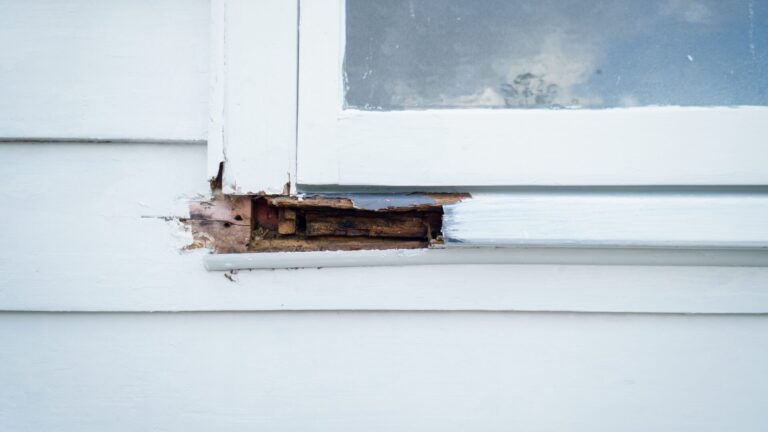
Wood gives our homes warmth, character, and strength. From framing to trim to windowsills, it’s one of the most common—and beautiful—materials used in construction. But wood also has one natural weakness: it’s vulnerable to rot.
If you’ve ever noticed soft spots in your siding, peeling paint that won’t stay put, or a musty smell coming from your deck or windows, you may already be dealing with wood rot. Left untreated, this issue can spread quietly and weaken the structure of your home.
So, what exactly is wood rot, how does it form, and what can you do to stop it before it causes costly damage? Let’s break it down.
The Basics: What Causes Wood Rot?
Wood rot is the natural breakdown of wood caused by fungi. These fungi thrive in damp, warm conditions and feed on the fibers that give wood its strength. When wood stays wet for too long, the fungus begins to grow, and the rot process starts.
There are three key ingredients fungi need to thrive:
- Moisture: Leaks, humidity, or water trapped behind paint or siding.
- Oxygen: Like any living organism, fungi need air.
- Food source: In this case, the wood itself.
Take away any one of these, and rot can’t survive. But in many homes, wood around windows, doors, trim, and decks gets just the right conditions to invite it in.
The Different Types of Wood Rot
Not all rot looks the same. Understanding the type of wood rot you’re dealing with can help homeowners know what’s happening in their home.
- Brown Rot (Dry Rot): Despite the name, dry rot needs moisture to grow. It breaks down cellulose, leaving wood brown, brittle, and crumbly.
- White Rot: This fungus attacks both cellulose and lignin, leaving wood with a whitish or yellowish look. It often feels spongy or stringy.
- Soft Rot: Slower to spread, soft rot thrives in cooler or very wet conditions. It gradually weakens wood, often behind siding or under shingles.
Each type weakens the wood and, if untreated, can compromise the stability of your home.
Warning Signs Homeowners Shouldn’t Ignore
Catching wood rot early makes all the difference. Here are the most common signs to watch for:
- Soft or spongy spots: Press gently on trim, siding, or deck boards. If the wood gives under pressure, it’s likely rotted.
- Peeling or bubbling paint: Paint that won’t hold often signals trapped moisture beneath the surface.
- Discoloration or stains: Dark patches, streaks, or uneven coloring on wood may point to fungus growth.
- Musty odors: That damp, earthy smell can indicate hidden rot.
- Cracking or crumbling wood: Brown rot especially leaves wood fragile and easy to break apart.
If you see or suspect these issues, don’t wait—rot spreads faster than most homeowners realize.
Why Wood Rot is a Big Deal
Some people think of wood rot as just cosmetic, but it’s far more serious. Untreated rot can:
- Weaken structural framing: Floor joists, roof decking, and support beams lose their strength.
- Damage curb appeal: Trim, siding, and exterior wood features look unsightly.
- Encourage pests: Termites and carpenter ants thrive in softened wood.
- Lower home value: Buyers and inspectors view rot as a red flag.
Ignoring wood rot today almost always leads to bigger, costlier repairs tomorrow.
Where Wood Rot Commonly Appears
Certain areas of your home are more vulnerable because they’re exposed to the elements or prone to moisture. These include:
- Windows and doors: Water sneaks past failing caulking or flashing.
- Trim and fascia boards: Rainwater and humidity collect around rooflines.
- Decks and porches: Constant exposure to rain and ground moisture makes them high-risk areas.
- Basements and crawl spaces: Damp environments provide ideal conditions for fungi.
- Roof decking: A small leak can spread moisture into the plywood under shingles.
Knowing where to look helps you spot issues before they spread too far.
Traditional Fixes vs. Permanent Solutions
Many homeowners assume the only solution is to cut out the damaged area and replace it. While replacement works, it’s often expensive, time-consuming, and disruptive—especially if the rot is widespread.
Other quick fixes, like fillers or putty, may patch the surface but don’t solve the underlying issue. These temporary repairs often fail within a year or two, leaving you right back where you started.
That’s why Preservan takes a different approach. We use eco-friendly epoxy resin treatments to remove the rot and permanently restore the strength of your wood. The process is less invasive than replacement, costs less, and preserves the original character of your home while stopping fungi in their tracks.
How Homeowners Can Help Prevent Wood Rot
While not all rot can be prevented, a few simple habits reduce your risk:
- Maintain paint and caulking: A solid seal keeps water out.
- Keep gutters clear: Prevents overflow that soaks trim or siding.
- Watch for leaks: Fix plumbing, roof, or flashing leaks quickly.
- Promote airflow: Ventilate attics, crawl spaces, and basements to reduce humidity.
These steps, combined with regular inspections, make it easier to catch small issues before they become major ones.
Preservan is Your Neighbor in Wood Rot Repair
Discovering wood rot can feel overwhelming, but you don’t have to face it alone. At Preservan, we’ve helped homeowners across the country stop rot in its tracks and restore their homes with lasting solutions.
We approach each project like we’re helping a neighbor—because we know how stressful it is to see your home damaged. Our proven, eco-friendly repair process eliminates the fungus, strengthens your wood, and gives you peace of mind that the problem is solved the right way.If you’ve noticed soft spots, peeling paint, or other warning signs, don’t wait for the damage to spread. Book an assessment for a free quote today, and let Preservan show you how easy and effective permanent wood repair can be.
